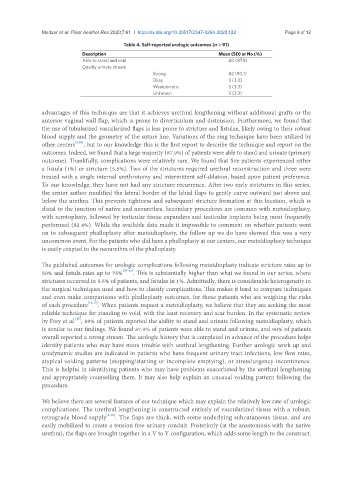Page 721 - Read Online
P. 721
Meltzer et al. Plast Aesthet Res 2020;7:61 I http://dx.doi.org/10.20517/2347-9264.2020.122 Page 9 of 12
Table 4. Self-reported urologic outcomes (n = 91)
Description Mean (SD) or No (%)
Able to stand and void 80 (87.9)
Quality urinary stream
Strong 82 (90.1)
Okay 3 (3.3)
Weak/erratic 3 (3.3)
Unknown 3 (3.3)
advantages of this technique are that it achieves urethral lengthening without additional grafts or the
anterior vaginal wall flap, which is prone to diverticulum and distension. Furthermore, we found that
the use of tubularized vascularized flaps is less prone to stricture and fistulae, likely owing to their robust
blood supply and the geometry of the suture line. Variations of the ring technique have been utilized by
other centers [9,10] , but to our knowledge this is the first report to describe the technique and report on the
outcomes. Indeed, we found that a large majority (87.9%) of patients were able to stand and urinate (primary
outcome). Thankfully, complications were relatively rare. We found that five patients experienced either
a fistula (1%) or stricture (5.5%). Two of the strictures required urethral reconstruction and three were
treated with a single internal urethrotomy and intermittent self-dilation, based upon patient preference.
To our knowledge, they have not had any stricture recurrence. After two early strictures in this series,
the senior author modified the lateral border of the labial flaps to gently curve outward just above and
below the urethra. This prevents tightness and subsequent stricture formation at this location, which is
distal to the junction of native and neourethra. Secondary procedures are common with metoidioplasty,
with scrotoplasty, followed by testicular tissue expanders and testicular implants being most frequently
performed (82.4%). While the available data made it impossible to comment on whether patients went
on to subsequent phalloplasty after metoidioplasty, the follow up we do have showed this was a very
uncommon event. For the patients who did have a phalloplasty at our centers, our metoidioplasty technique
is easily coapted to the neourethra of the phalloplasty.
The published outcomes for urologic complications following metoidioplasty indicate stricture rates up to
50% and fistula rates up to 75% [10-12] . This is substantially higher than what we found in our series, where
strictures occurred in 5.5% of patients, and fistulas in 1%. Admittedly, there is considerable heterogeneity in
the surgical techniques used and how to classify complications. This makes it hard to compare techniques
and even make comparisons with phalloplasty outcomes, for those patients who are weighing the risks
of each procedure [13,14] . When patients request a metoidioplasty, we believe that they are seeking the most
reliable technique for standing to void, with the least recovery and scar burden. In the systematic review
[15]
by Frey et al. , 89% of patients reported the ability to stand and urinate following metoidioplasty, which
is similar to our findings. We found 87.9% of patients were able to stand and urinate, and 90% of patients
overall reported a strong stream. The urologic history that is completed in advance of the procedure helps
identify patients who may have more trouble with urethral lengthening. Further urologic work up and
urodynamic studies are indicated in patients who have frequent urinary tract infections, low flow rates,
atypical voiding patterns (stopping/starting or incomplete emptying), or stress/urgency incontinence.
This is helpful in identifying patients who may have problems exacerbated by the urethral lengthening
and appropriately counselling them. It may also help explain an unusual voiding pattern following the
procedure.
We believe there are several features of our technique which may explain the relatively low rate of urologic
complications. The urethral lengthening is constructed entirely of vascularized tissue with a robust,
retrograde blood supply [6,16] . The flaps are thick, with some underlying subcutaneous tissue, and are
easily mobilized to create a tension free urinary conduit. Posteriorly (at the anastomosis with the native
urethra), the flaps are brought together in a V to Y configuration, which adds some length to the construct.

